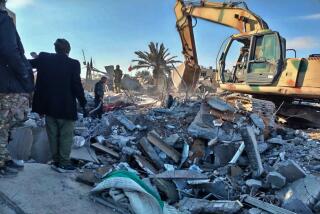Scaled-Down Missile Defense Has Merit : A Limited Shield Could Protect Superpowers From Renegade Launch
- Share via
One of the major issues that will be debated in this presidential campaign is the role of “Star Wars.”
It is an issue that has divided the two political parties and hampered policy-making for five years. We now have the opportunity to break this gridlock.
The time has finally come to postpone indefinitely the President’s vision of a full strategic defense designed to render nuclear weapons “obsolete.” Instead, we should focus on developing a light ballistic-missile defense capable of protecting us against an accidental or unauthorized launch, as well as the growing threat of a third-party attack. This approach is far more realistic, and the need is far more pressing.
A bipartisan coalition for such a policy is already in the making. Sen. Sam Nunn of Georgia, a Democrat and the influential chairman of the Senate Armed Services Committee, has recommended that we explore the development of a limited shield. His message is clear: While a total population defense may currently be pie-in-the-sky, this should in no way invalidate the role that defense can play.
The Administration is slowly but surely moving in this direction, as well. Both Secretary of Defense Frank C. Carlucci and a panel of Pentagon experts have called for a substantial scaling back of the more ambitious deployment schemes of earlier years.
Thus, after years of divisive partisan bickering and ongoing battles between Congress and the Administration, we now have the chance to put together a workable and politically sustainable policy. It should not be squandered.
This is not to say, however, that a modest defense system is free of its detractors.Critics cite redundancies in the command and control of nuclear weapons, and of increasingly refined technological safeguards, as evidence of the improbable likelihood of an accidental or unauthorized launch. But the episode in the Persian Gulf in which the U.S. warship Vincennes shot down an Iranian civilian jetliner is yet another reminder of the ongoing potential for accidents, in spite of our best technology. Even if the statistical chance is remote in times of peace, the probability rises exponentially during a political crisis, when a series of incremental events could lead to a combination--intended or not--resulting in a missile attack.
It is this scenario, not the massive Soviet bolt-out-of-the-blue attack that is now comfortably prevented by nuclear deterrence, that we have to be the most worried about.
In the face of this, it is unconscionable that the range of choices facing the President is so limited. Confronted with the prospect of just one nuclear warhead landing on any major metropolitan area, he has three options: Do nothing, attempt a chaotic evacuation, respond in kind. All are equally unacceptable choices, and all entail disastrous results.
Equally significant, this is not all that different from the choices that the Soviet Union would confront in a similar situation, despite the anti-ballistic-missile batteries around Moscow.
The United States currently has to concern itself only with the Soviet nuclear threat and a future third-party attack. But the Soviets have to worry about the nuclear capabilities of the Americans, the British, the French and the Chinese, as well as the ever-increasing proliferation of medium-range missiles in the Middle East that are capable of reaching Russian soil. The Iranians, the Iraqis, the Saudis and the Israelis are all positioned to pose a potential danger to the Soviets.
So there are independent--indeed, legitimate--reasons for the Soviets to pursue a light missile-defense system of their own--a fact that even conservative purists must acknowledge. Irrespective of U.S. actions, the Soviets may eventually find that they have no choice but to deploy their own defenses. If this happened, it is inconceivable that the United States would stand idly by and not respond with an accelerated program of its own. This sequence, rather than the ones that are usually set forth by Star Wars critics, could lead to the kind of overreaction that would likely generate another costly upward spiral in the arms race.
Recognizing this, however, we have a unique opportunity to build a more stable arrangement with the Soviets. We should explore with them a new arms-control regime entailing mutual deployment of a light defense system for both countries. While establishment of such a framework would undoubtedly require certain modifications to the 1972 anti-ballistic-missile treaty, the superpowers would gain far greater mutual security than they now possess with SDI being a major sticking point in the arms-reduction talks.
We can never achieve a posture of total invulnerability, much as we may yearn for it. But we can develop the means to save millions of lives in the event of a limited accidental, unauthorized or third-party attack. For the United States and the Soviet Union it would represent a morally appropriate and genuinely workable policy.
More to Read
Get the L.A. Times Politics newsletter
Deeply reported insights into legislation, politics and policy from Sacramento, Washington and beyond. In your inbox twice per week.
You may occasionally receive promotional content from the Los Angeles Times.










